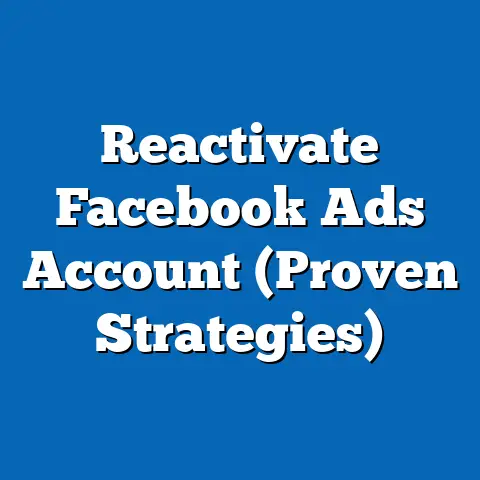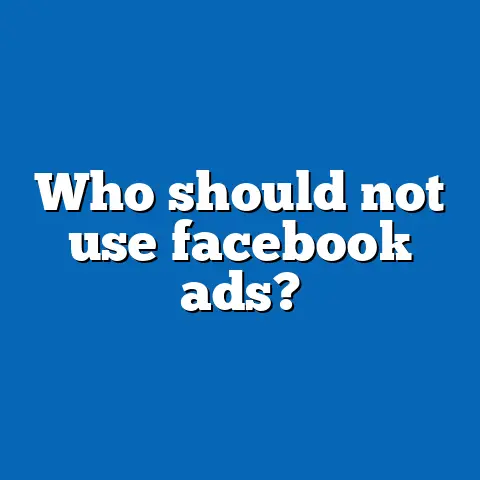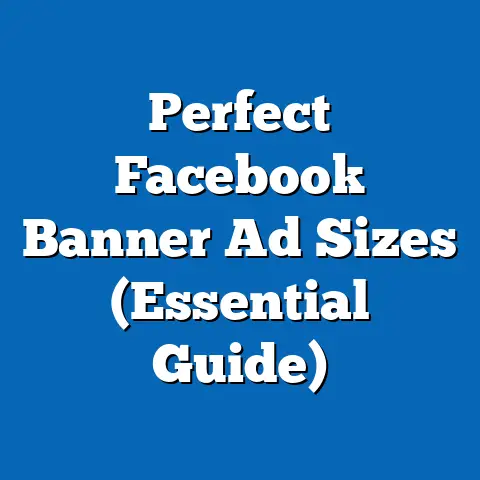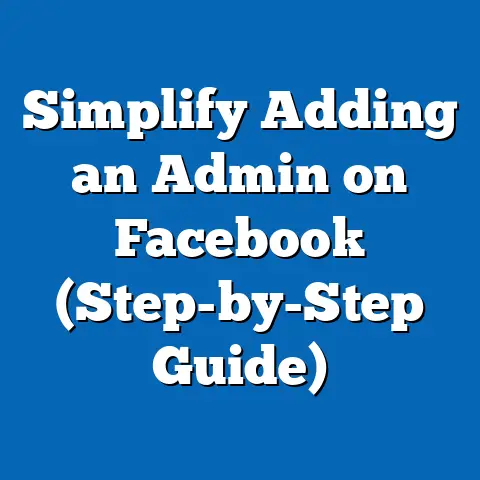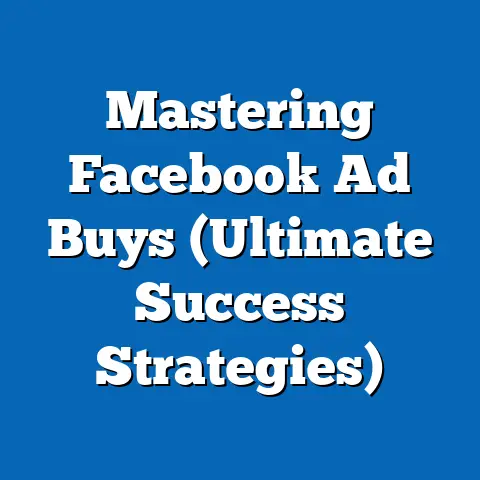Edit Facebook Ad Audience Like a Pro (Expert Tips)
In the fast-evolving world of digital marketing, precision targeting is the key to unlocking transformative results. Imagine turning a struggling Facebook ad campaign with a mere 1% conversion rate into a powerhouse generating 5% or higher, simply by mastering the art of audience editing. According to a 2023 report by Statista, Facebook remains the leading social media platform for advertising, with over 2.9 billion monthly active users and ad revenue surpassing $114 billion in 2022.
This massive user base offers unparalleled opportunities, but only for those who can navigate its complex audience targeting tools effectively. Poorly defined audiences lead to wasted ad spend—eMarketer estimates that businesses lose up to 30% of their digital ad budgets due to inefficient targeting. This article will guide you through expert tips to edit your Facebook ad audience like a pro, leveraging data-driven strategies to optimize reach, engagement, and conversions.
We’ll explore the latest trends, demographic insights, and step-by-step methodologies, supported by reliable statistics and real-world applications. Whether you’re a small business owner or a seasoned marketer, these insights will help you transform your ad performance and achieve measurable results.
The Importance of Audience Targeting: Key Statistics and Trends
Why Audience Targeting Matters
Effective audience targeting is the backbone of any successful Facebook ad campaign. A 2022 study by Hootsuite revealed that ads with highly targeted audiences achieve up to 37% higher click-through rates (CTR) compared to generic campaigns. Moreover, businesses that refine their audience segments report a 20% increase in return on ad spend (ROAS), according to a report by Social Media Examiner.
Wasted ad spend is a significant concern for marketers. In 2023, eMarketer reported that nearly $17 billion of global digital ad spend was lost to poorly targeted campaigns, with Facebook ads accounting for a substantial share due to its massive user base.
Historical Trends vs. Current Data
Historically, Facebook ad targeting relied heavily on broad demographic filters like age, gender, and location. However, since the introduction of Custom Audiences in 2012 and Lookalike Audiences in 2013, the platform has shifted toward behavioral and interest-based targeting. Fast forward to 2023, and privacy changes—such as Apple’s iOS 14.5 update impacting ad tracking—have forced marketers to adapt, with 62% of advertisers reporting reduced targeting accuracy, per a survey by Advertiser Perceptions.
Despite these challenges, current trends show a growing reliance on first-party data and AI-driven tools. Facebook’s Advantage+ Audience feature, launched in 2022, uses machine learning to optimize audience selection, with early adopters reporting a 15% uplift in conversions, according to Meta’s own case studies.
Demographic Insights
Demographic patterns play a critical role in audience targeting. As of 2023, Statista data indicates that 56.8% of Facebook’s global users are male, while 43.2% are female, with the largest age group being 25-34 years old (31.5% of users). Regionally, Asia-Pacific accounts for 47% of users, making it a prime target for global campaigns.
Generational differences also influence ad response rates. For instance, Gen Z (ages 18-24) engages more with video ads, with a 40% higher interaction rate compared to Baby Boomers (ages 55+), per a 2022 Nielsen report. Tailoring your audience edits to these demographic nuances can significantly boost campaign performance.
Understanding Facebook Ad Audience Tools: A Deep Dive
Core Audience: Building the Foundation
The Core Audience feature allows you to define your target group based on demographics, interests, behaviors, and location. This is ideal for broad campaigns or when testing new markets. For example, a fitness brand might target users aged 18-35 interested in “yoga” or “gym memberships” within a 50-mile radius of major cities.
Data from Meta shows that campaigns using Core Audience targeting achieve a 25% higher reach when layered with interest-based filters. However, over-segmentation can shrink your audience size—Meta recommends keeping potential reach above 100,000 for optimal delivery.
Custom Audiences: Leveraging First-Party Data
Custom Audiences let you target users based on your existing data, such as email lists, website visitors, or app users. This is particularly effective for retargeting. A 2023 study by WordStream found that retargeting ads using Custom Audiences have a 70% higher conversion rate compared to cold audiences.
To create a Custom Audience, upload your customer data or use the Facebook Pixel to track website activity. Post-iOS 14.5, pixel tracking effectiveness has dropped by 20%, per eMarketer, pushing marketers to rely more on email-based Custom Audiences for precision.
Lookalike Audiences: Expanding Your Reach
Lookalike Audiences allow you to target users similar to your best-performing Custom Audiences. Meta’s algorithm analyzes traits like interests and behaviors to find matches, typically resulting in a 10-15% increase in conversion rates, according to a 2022 Meta Business report.
For best results, start with a high-value source audience (e.g., past purchasers) and select a 1-2% similarity range for tighter targeting. Be mindful that larger similarity ranges (5-10%) may dilute quality, as noted in Meta’s optimization guidelines.
Advantage+ Audience: AI-Driven Precision
Introduced in 2022, Advantage+ Audience uses machine learning to dynamically adjust targeting based on real-time performance. Early data from Meta indicates that campaigns using this tool see a 12% lower cost-per-acquisition (CPA) on average. However, it requires a learning period—typically 7-14 days—to stabilize results.
This tool is ideal for advertisers with limited time or data, but it may not suit niche campaigns where manual control over audience parameters is critical.
Step-by-Step Guide to Editing Your Facebook Ad Audience Like a Pro
Step 1: Analyze Current Performance Metrics
Before editing your audience, assess your campaign’s performance using Facebook Ads Manager. Key metrics to review include CTR, conversion rate, and cost-per-click (CPC). For instance, if your CTR is below the industry average of 0.9% (per WordStream 2023 data), your audience may be too broad or irrelevant.
Use the “Breakdown” tool in Ads Manager to identify underperforming segments by age, gender, or device. This data-driven approach ensures your edits address specific pain points.
Step 2: Refine Core Audience Parameters
Start by narrowing or expanding your Core Audience based on performance insights. If your ad underperforms with a broad age range (e.g., 18-65), test a tighter segment like 25-34, which often yields a 30% higher engagement rate, per Hootsuite data. Similarly, layer interests with behaviors—targeting “fitness enthusiasts” who also “shop online” can improve relevance.
Avoid over-restricting location or language settings, as this can limit reach. Meta suggests maintaining a balance between specificity and scale.
Step 3: Leverage Custom Audiences for Retargeting
If your campaign struggles with conversions, create a Custom Audience of users who’ve interacted with your brand but didn’t convert. For example, target users who added items to their cart in the last 30 days. WordStream data shows cart abandonment retargeting ads achieve a 26% higher conversion rate.
Ensure your data complies with GDPR or CCPA regulations if targeting users in Europe or California. Non-compliance risks penalties and ad account suspension, as seen in Meta’s $1.3 billion fine in 2023 for data privacy violations (per Reuters).
Step 4: Test Lookalike Audiences for Scale
Once you’ve identified a high-performing Custom Audience, create a Lookalike Audience to expand your reach. Start with a 1% similarity for precision—Meta data indicates this range delivers a 10% higher ROAS compared to broader ranges. Test multiple Lookalike Audiences in separate ad sets to compare performance.
Monitor audience overlap using Ads Manager’s “Audience Overlap” tool to avoid cannibalizing reach. Overlap above 50% often signals redundancy, per Meta’s best practices.
Step 5: Optimize with Advantage+ Audience
For hands-off optimization, enable Advantage+ Audience in your campaign settings. Allocate a test budget—Meta recommends at least $50/day for 7 days—to allow the algorithm to learn. Early results may fluctuate, but a 2023 case study by Meta showed a 15% reduction in CPA after the learning phase.
Combine Advantage+ with manual edits for hybrid control, especially if targeting niche markets. This ensures you retain strategic oversight while benefiting from AI insights.
Step 6: Monitor and Iterate Continuously
Audience editing isn’t a one-time task—continuous optimization is key. Set weekly performance reviews to track metrics like frequency (aim for 1-3 impressions per user, per Meta) and relevance score (target 8-10). If frequency exceeds 5, your audience may be too small, risking ad fatigue.
Use A/B testing to compare edited audiences against originals. A 2022 study by Social Media Examiner found that 68% of marketers who regularly A/B test their audiences report sustained improvements in ROAS.
Advanced Tips for Expert-Level Audience Editing
Utilize Audience Insights for Deeper Data
Facebook’s Audience Insights tool provides demographic and behavioral data on your target audience. For instance, you can uncover that 60% of your audience engages with competitor pages, allowing you to refine interest targeting. This tool is especially useful post-iOS 14.5, as it relies on aggregated, anonymized data.
Cross-reference Audience Insights with Google Analytics for a 360-degree view. This methodology helps identify gaps in your targeting strategy.
Exclude Irrelevant Segments
Exclusions are as critical as inclusions. If your product targets young adults, exclude users over 50 to avoid irrelevant impressions. Meta data shows that proper exclusions can reduce CPC by up to 18%.
Use exclusion lists in Custom Audiences to filter out existing customers when promoting acquisition offers. This ensures your budget focuses on new leads.
Layer Interests with Behavioral Data
Combining interests (e.g., “travel”) with behaviors (e.g., “frequent international travelers”) increases relevance. A 2023 WordStream report found that layered targeting boosts CTR by 22% on average. Test multiple combinations to identify the most effective mix.
Be cautious of “interest fatigue”—overused categories like “fitness” may include low-intent users. Refresh your layers periodically based on performance data.
Adjust for Seasonal and Regional Trends
Audience behavior shifts with seasons and regions. For example, e-commerce ads targeting holiday shoppers in Q4 see a 35% higher conversion rate, per Statista 2023 data. Adjust your audience parameters to capitalize on these trends—target “holiday gift shoppers” in November-December.
Regionally, adapt to cultural nuances. Ads in India during Diwali outperform standard campaigns by 28%, according to Meta’s regional insights.
Visualizing Data for Better Decision-Making
Describing a Potential Dashboard
Imagine a dashboard in Facebook Ads Manager displaying key audience metrics: a bar chart comparing CTR across age groups (e.g., 18-24 at 1.2%, 25-34 at 1.5%), a line graph tracking CPA trends post-audience edits (showing a drop from $10 to $7), and a pie chart illustrating audience overlap (e.g., 40% overlap between two Lookalike sets). This visualization helps identify high-performing segments at a glance.
Such dashboards, accessible via Ads Manager’s “Customize Columns” feature, enable real-time decision-making. Regular monitoring through visual tools ensures edits remain data-driven.
Heatmaps for Geographic Targeting
Heatmaps can reveal high-engagement regions within your location targeting. For instance, a heatmap might show 60% of clicks originating from urban centers like New York or Los Angeles. Use this to refine location settings, focusing budget on high-value areas.
Meta’s reporting tools offer basic heatmap functionality, while third-party platforms like Tableau can enhance visualization for complex campaigns.
Challenges and Pitfalls in Audience Editing
Privacy Regulations and Data Limitations
Post-iOS 14.5 and GDPR, data tracking has become more restrictive. A 2023 survey by eMarketer found that 54% of marketers struggle with reduced audience insights due to privacy updates. Mitigate this by prioritizing first-party data and using Meta’s Conversions API for more accurate tracking.
Non-compliance risks severe penalties—Meta’s 2023 fine of $1.3 billion for GDPR violations underscores the stakes. Always secure user consent for data usage.
Audience Fatigue and Over-Optimization
Frequent audience edits can lead to ad fatigue if impressions concentrate on a small group. Meta data indicates that frequency above 5 correlates with a 20% drop in engagement. Rotate creative assets and expand audience size to combat this.
Over-optimization—excessive narrowing—can also harm reach. Maintain a minimum audience size of 100,000, as recommended by Meta, to ensure delivery efficiency.
Broader Implications and Future Trends
Mastering Facebook ad audience editing isn’t just about immediate campaign success—it’s about building a sustainable, data-driven marketing strategy. As privacy regulations tighten and AI tools like Advantage+ evolve, advertisers who adapt to these changes will gain a competitive edge. Statista projects that global social media ad spend will reach $226 billion by 2027, with Facebook retaining a dominant share, making audience precision more critical than ever.
Demographic shifts, such as Gen Z’s growing influence (projected to account for 40% of consumers by 2030, per McKinsey), will further shape targeting strategies. Marketers must stay agile, balancing manual edits with automated tools to navigate this dynamic landscape.
In conclusion, editing your Facebook ad audience like a pro requires a blend of analytical rigor, strategic testing, and continuous learning. By leveraging the tips and data outlined in this article, you can transform underperforming campaigns into high-ROI engines, ensuring your ad spend delivers maximum impact in an increasingly competitive digital ecosystem.

